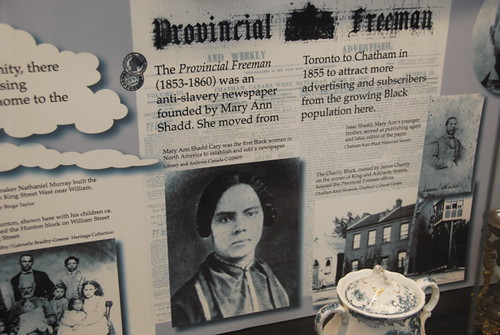
19th Century abolitionist Mary Ann Shadd who founded the Provincial Freeman newspaper in Toronto, Canada in 1853. She relocated the publication to Chatham in 1855 to enhance sales and advertising., a photo by Pan-African News Wire File Photos on Flickr.
October 16, 2013 3:22 PM
Delivery costs, declining readership buffet African-American newspapers
By Bill Shea
Detroit Crain's Business
African-American newspapers have struggled with the same declines in circulation and advertising revenue that have plagued the overall print newspaper industry for years, but they face unique challenges as well.
Because black populations were largely segregated in U.S. cities, newspapers aimed at them during the 20th century were able to more easily circulate among them — something lost as desegregation allowed African-Americans to finally freely move and work where they wished, said Rick Edmonds, a media business analyst with the St. Petersburg, Fla.-based Poynter Institute for Media Studies, a journalism school and think tank.
That's a problem Detroit-based Real Times Media LCC is dealing with, said CEO Hiram Jackson.
"The African-American community is very dispersed. Delivery is expensive," he said.
Real Times publishes the Michigan Chronicle, which Jackson said has about 30,000 paid subscribers, and newspapers in several other cities.
Jackson said a 2011 report by the Chicago Sun-Times was inaccurate that the Real Times-owned Chicago Defender, one of the nation's oldest and most venerated black newspapers, was behind in lease payments for its office.
He also said the paper has had an operating profit for the past two years, but he acknowledged a series of layoffs. Its circulation has dipped under 8,000.
"We've had challenges in Chicago. It's a market aggressive on the digital side. We've had to make some serious adjustments in Chicago, but we're still pretty stable there," he said. "We've going through some heavy restructuring with our employee mix."
The Defender reduced circulation to one day a week, down from four days, in 2008 to save money. Its publisher, Michael House, retired on Sept. 30.
There also are age-related challenges for black-audience newspapers.
"In addition to the geographic spread that makes circulation a difficult proposition, there are demographic issues related to the black community that I suspect places Real Times in further jeopardy," said Clint Wilson, a professor of journalism at Howard University's School of Communications.
"Readership of the black press is almost nil among the 18- to 30-year-old group nationally, and the (Pew Research Center's Project for Excellence in Journalism) research has shown a major trend in that demographic toward social media instead of traditional print news sources. The older generation is phasing out."
While Detroit remains a majority black city, its financial problems exacerbate the newspaper issues for the black press: Evidence has long shown that poor people, no matter their race, subscribe to newspapers at lower rates.
"The economic problems facing Detroit makes matters even more acute for the African-American papers in town," Wilson said.
The Pew research includes an annual report on the state of various news media, and it noted that black newspapers suffered the same advertising revenue and circulation declines as mainstream print outlets.
"In the newspaper sector, many historic African-American publications both lost circulation and struggled to find advertising revenue," Pew wrote.
Pew didn't track specific revenue trends for black newspapers, but the wider overall industry fell to $22.3 billion last year from $49.2 billion in 2006.
Pew's research found African-Americans using Facebook, Twitter and Instagram at higher rates than the general population, Tumblr at rates about the same as whites, and LinkedIn and Pinterest at lower rates.
That bolsters Jackson's strategy of pushing news content via Real Times' digital platforms.
"Our challenges are huge. It's a daunting time, but there are opportunities," he said.
No comments:
Post a Comment